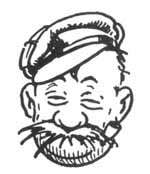Old Bill (comics)
| Old Bill | |
|---|---|
 Old Bill | |
| First appearance | 1914–1915 |
| Created by | Bruce Bairnsfather |
| Comic strip | Fragments from France |
Old Bill is a fictional character created in 1914–15 by cartoonist Bruce Bairnsfather. Old Bill was depicted as an elderly, pipe-smoking British "tommy" with a walrus moustache. The character achieved a great deal of popularity during World War I where it was considered a major morale booster for the British troops. Old Bill and his younger troopmate little Alphie were private infantrymen in the British Expeditionary Force.
Many claims have been put forth as being the model for "Old Bill" but the most likely appears to be Thomas Henry Rafferty, a lance corporal from Birmingham in Bairnsfather's regiment, the Royal Warwickshires, who was killed in the same action that invalided Bairnsfather in April 1915. Rafferty was featured in the Weekly Dispatch in 1917, referred to as "Old Bill," along with a photograph taken by Bairnsfather.
Adaptations
In 1917, a successful musical based on the character, The Better 'Ole, opened in London at the Oxford Music Hall, where it ran for over 800 performances, starring Arthur Bourchier as Old Bill.[1] It later also ran successfully on Broadway, where Charles Coburn starred as Old Bill. The success of the piece led to a West End sequel, Old Bill, M.P., which opened at the Lyceum Theatre, London on 12 July 1922. Old Bill was played by Edmund Gwenn, and Bairnsfather appeared as himself. Unlike The Better 'Ole, the later piece was not a musical.[2] It ran until 11 November 1922.[3]
Two film adaptations of The Better 'Ole were made during the silent era. The first, a 1919 British version, starred Charles Rock as Bill. The second version was a 1926 Warner Bros. production. This film—the second feature to use the Vitaphone sound process—starred Syd Chaplin as Old Bill.
Cultural impact

Bill & Alphie's, the Royal Military College of Canada on-campus cadet pub in Kingston, Ontario is named after Bruce Bairnsfather's Great War cartoon characters. Yeo Hall at the Royal Military College of Canada features sculptures of Bill and Alphie.
One of the explanations of the origin of the London slang term Old Bill, meaning the police, is that constables often used to sport "Old Bill" moustaches.[4]
A 1911 B-type London bus, one of 900 which served as troop transports in World War I, was restored and named "Old Bill" in 1926. It is now preserved in the Imperial War Museum.[5]
Captain Bruce Bainsfather in an interview in the London weekly Despatch 1917 identified the image of Thomas Henry Rafferty as the original Old Bill.
Notes
- ↑ "Bourchier, Arthur", Who Was Who, A & C Black, 1920–2007, online edn, Oxford University Press, December 2007, accessed 28 Oct 2008
- ↑ "Old Bill, M.P.", The Times, 13 July 1922, p. 12
- ↑ "Varieties &c", The Times, 11 November 1922, p. 8
- ↑ "Origins of the name "Old Bill"". Metropolitan Police. Mayor's Office for Policing and Crime. 2014. Retrieved July 26, 2014.
- ↑ "AEC B Type Bus (B43 Old Bill)". Imperial War Museum. IWM. 2014. Retrieved July 26, 2014.
External links
- The Better 'Ole (1919) at the Internet Movie Database
- The Better 'Ole (1926) at the Internet Movie Database